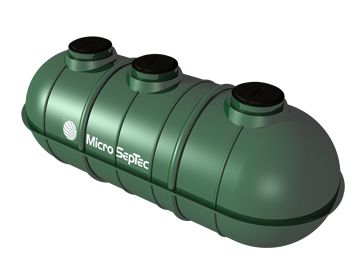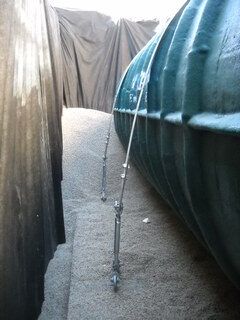One Tank, Five Chambers, Total Treatment
The EnviroServer is a pre-engineered, prefabricated Moving Bed Biological Reactor (MBBR) on-site wastewater treatment system that is typically used in areas where sewer is not available and conventional septic systems are not permissible due to environmental concerns. The system uses an accelerated natural biological process for wastewater treatment in a single tank design without employing any chemical or biological additives. The EnviroServer is engineered for dependability and proven reliability. It uses a heavy-duty fiberglass tank, which is the preferred method of storage for volatile fluids like gas and oil, and it employs industrial compressors and pumps (when needed) that function reliably for many years. The system is based on simple “plug and play” concepts to allow for quick installation and maintenance, with a minimum of moving parts.
The EnviroServer ES was the first small package residential MBBR product available in a self-contained single tank. As a result, it requires minimal excavation which reduces installation cost and it can be installed in lots with space constraints. The tank leaves a very small footprint, which can be camouflaged with flagstone, fake rocks, etc. while maintaining easy access for future maintenance of the system. There are no large, unsightly boxes or lids visible in the landscape. The tank can also be installed in traffic-rated situations with minimal special requirements.
Because the compressor is the only moving part, minimal upkeep is required. Routine maintenance and inspections are mandatory to meet warranty requirements. Regulatory agencies may have additional requirements above the minimum required by MicroSepTec. Typically, maintenance is performed on the EnviroServer in about an hour, keeping operational costs low. MicroSepTec trained and authorized personnel must complete the installation, startup, inspections, service, and maintenance of the EnviroServer unit.
When properly designed, installed, and maintained, there are no sewer gas smells with the EnviroServer because it uses high-efficiency, low-flow compressors that run continuously and with no noticeable noise.
Optional equipment includes mechanical recirculation pump, ultra-violet disinfection, and telemetry. The system can be configured to meet the needs of each specific site.
Why the EnviroServer?
One Tank, Five Compartments, Total Treatment: No other system can accomplish primary and secondary treatment, denitrification, UV disinfection and pressurized effluent dispersal in a single tank.
Environmentally friendly: The three 24″ round riser lids can easily be hidden in the landscape, with the compressor and controller mounted remotely. The low-flow compressor is very quiet, and a healthy system emits no noticeable odor.
Simple to design: The pre-engineered system comes in three sizes: 600, 1,200 or 2,500 GPD and attains the highest treatment levels. The designer simply selects the size and options (effluent pump, disinfection, telemetry) needed for the project.
Easy to install: The EnviroServer ES is self-contained in one fiberglass tank, requiring a single excavation. Using plug-n-play concepts, the connections and internal component assembly can be completed in a couple of hours.
Minimal maintenance: Because there is no filter media, small orifices or submersed pumps to maintain, periodic maintenance can be completed very quickly. The compressor (one or two) is the only moving part and all components are easily accessible at grade.
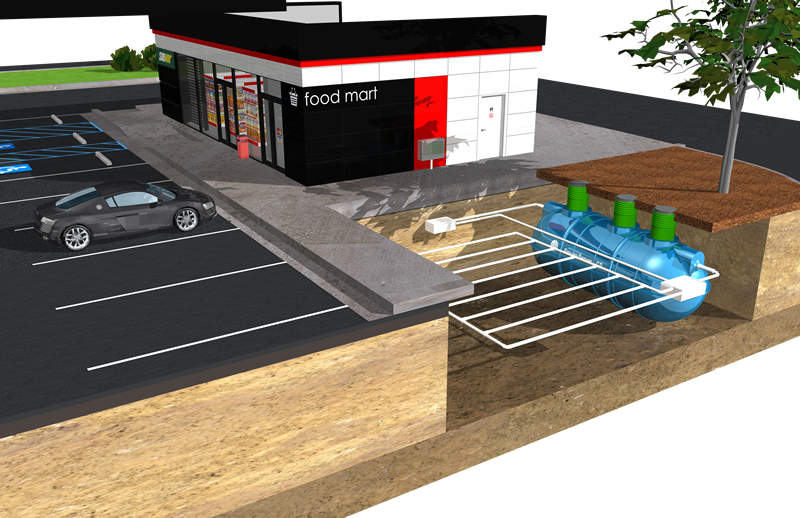
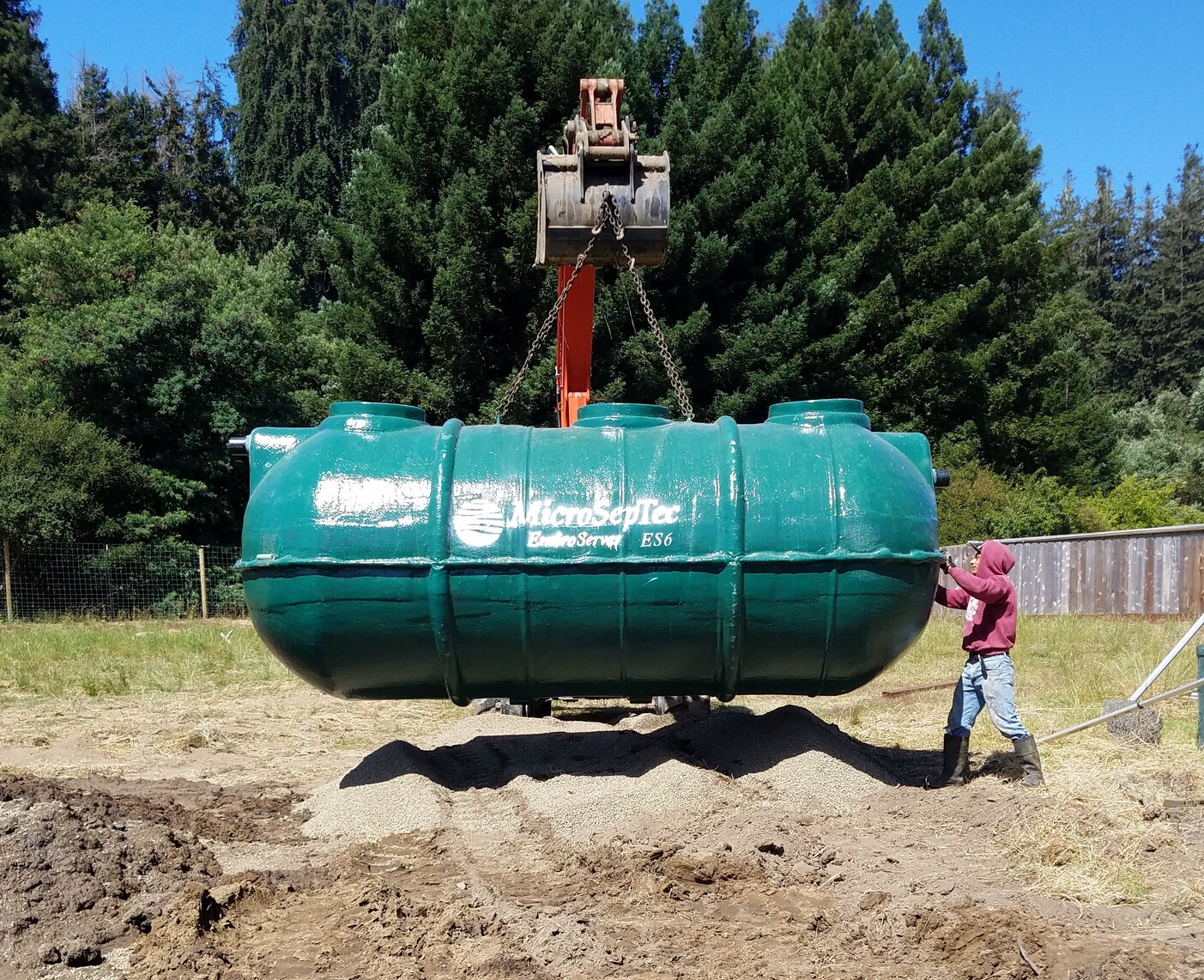
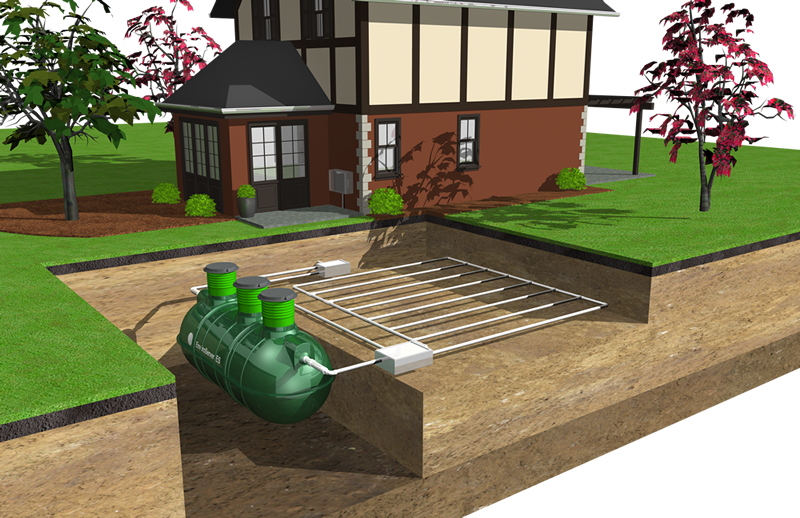
 Stage 1 – Primary Clarification
Stage 1 – Primary Clarification
The figure above shows a process flow diagram of the EnviroServer ES Model. Wastewater influent from the house is gravity fed into the first compartment (Primary Clarifier) of the system. In the first compartment, settling of the sludge and solids occurs. The primary clarified wastewater overflows into the second compartment of the system (First Aeration Chamber) through sanitary tees.
Stage 2 – Biological Organic Removal
In the second compartment, the wastewater is aerated using a high-efficiency low-pressure air compressor and a fine-bubble membrane air diffuser assembly. The diffuser assembly is custom designed to ensure maximum oxygen transfer and optimum mixing of dissolved substrates and oxygen. Furthermore, the mixing ensures the solids remain suspended within the reactor and that the biomedia does not clog. The aeration promotes the growth of aerobic microorganisms, which convert and remove biodegradable organic matter. (The organics removed by the aerobic process are the constituents that are measured in the CBOD5 test.)
To optimize the contact time and the mean cell residence time, the EnviroServer utilizes a biomedia in the aerobic sections. This plastic media is used to supply a support structure for the establishment of a resident biofilm and is specifically developed for optimized biological growth without clogging. The design allows the biomass to attach to the biomedia and not flush out during high flow rates. The biomedia also enhances the nitrification process, which requires a larger population of organisms due to the lower metabolic rate of the nitrifying bacteria.
Stage 3 – Biological Ammonia Conversion (Nitrification)
The partially treated wastewater, now low in carbon but high in ammonia, flows into the third compartment (Second Aeration Chamber) of the system and is aerated in the same manner as the second compartment. The combination of low carbon content, high ammonia, and high oxygen levels in this chamber promotes the growth of nitrifying microorganisms (Nitrosomonas and Nitrobacter). The nitrifying microorganisms convert ammonia to nitrates utilizing the oxygen in the wastewater.
Stage 4 – Clarification
The two-stage aerobically treated wastewater, which is now high in nitrates but low in carbon (BOD), flows into the fourth compartment (Final Clarifier) of the system where clarification and settling of suspended solids occurs.
Stage 5 – Nitrate Removal
To promote denitrification, the wastewater is recirculated from the final clarifier back to the primary clarifier, which contains sufficient carbon to promote denitrification. Denitrification occurs because the bacteria in the primary (anoxic) clarifier use the oxygen from the nitrate molecules in their metabolic process; the nitrogen left over from this reaction is then released as a gas.
Stage 6 – Solids Removal
The recirculation also helps prevent accumulation of biomass in the final clarifier, decreasing the need for periodic removal. Removing the accumulated biomass helps ensure optimum clarifier performance, resulting in an effluent with low suspended solids. The transfer of the biomass to the primary clarifier ensures a large vital population of microorganisms for the organic and nitrogen removal processes in the aeration compartments. When the water is recirculated, it carries nutrients from the primary clarifier into the aeration compartments. Thus, the available nutrients are utilized to sustain the population as long as possible, particularly in times of low loading such as vacation periods. In normal operation, this keeps sludge build-up to a minimum by helping break up and dissolve the solids, thereby making the nutrients available for the microorganisms.
Because of the recirculation, the sludge is accumulated and stored in the primary clarifier. The primary clarifier is sized to hold sludge for one to three years, depending on the usage of the system, and will need to be pumped as needed. The first baffle is reinforced to be able to withstand the hydraulic pressure of the first compartment being empty and the second full.
The EnviroServer ES was the first small package residential MBBR product available in a self-contained single tank. As a result, it requires minimal excavation which reduces installation cost and it can be installed in lots with space constraints. The tank leaves a very small footprint, which can be camouflaged with flagstone, fake rocks, etc. while maintaining easy access for future maintenance of the system. There are no large, unsightly boxes or lids visible in the landscape. The tank can also be installed in traffic-rated situations with minimal special requirements.
Designers
The EnviroServer is a pre-engineered pre-packaged MBBR aerobic treatment system designed to treat domestic strength wastewater. There are several models available in the ES series. Before choosing the EnviroServer model needed for the site, the designer should verify the following information:
Standard design
- Type of facility generating wastewater
- If the system is generating nonresidential wastewater consult with MicroSepTec on design parameters
- Effluent quality required as per local code
- Gallons Per Day (hydraulic loading)
- Using the chart at the beginning of this section, select the EnviroServer that is closest to the estimated hydraulic loading
- Do not select a system if you expect the actual flows will be greater than design flow
- Availability of electrical supply for the EnviroServer
- Influent characteristics (NSF/ANSI standard 40 CLASS I) – The following typical residential influent wastewater characteristics must be met to meet treatment standard for NSF/ANSI 40 CLASS I Treatment standards.
- BOD5: 100-300 mg/L
- TSS: 100-350 mg/L
- FOG: <50 mg/L
- Temperature: 50F-86F
Denitrification Design
The key to superior denitrification is controlled recirculation of treated wastewater through a treatment system that contains biomedia for attached growth of beneficial organisms. These organisms aid and support the denitrification process.
The EnviroServer was specifically developed for denitrification of wastewater. In the standard operation of the system with typical residential strength wastewater the EnviroServer will reduce total Nitrogen by 50%. If greater than 50% reduction of Nitrogen is required, timed recirculation should be used, using either a Solenoid Valve or Mechanical Recirculation Pump (MRP). If greater than 65% reduction in Nitrogen is required, MicroSepTec must be consulted for system design. With designs of greater than 65% reduction in Nitrogen, MicroSepTec may require additional chemical feeds needed to control PH, Alkalinity, Phosphorous and other chemicals that affect the stoichiometry of the system to ensure the desired effluent quality is met. It is highly recommended that flow monitoring be used to control proper recirculation ratio.
- Choose a model that is as close to designed Gallons Per Day required without under-sizing
- Metered effluent flow of the system is needed for proper adjustment of recirculation
- If targeted effluent Total Nitrogen is less than 25mg/L it is highly recommended that pump discharge with a flow meter (both supplied by others) be installed to help determine actual flows for setting proper recirculation, future service, and trouble-shooting
- Known or estimated influent organic load
- Desired effluent quality for local jurisdiction
- Future potential high and low flow situations
- Influent characteristics (NSF/ANSI Standard 245) – The following typical residential influent wastewater characteristics must be met in order to meet minimal treatment of 50% denitrification
- BOD5: 100-300 mg/L
- TSS: 100-350 mg/L
- TKN: 35-70 mg/L
- FOG: <50 mg/L
- Alkalinity:> 7:1 ratio no less than 175 mg/L (alkalinity may need adjusting in certain situations)
- Temperature: 50F-86F
- PH: 7.5-8.0 SU
Installers
The EnviroServer ES Series can be installed on a variety of sites and conditions including steep sloping landscapes, small lots, ocean front, lake shore, high elevation, cold weather, and hard-to-reach locations. The simply one tank design of the EnviroServer makes installation smooth and easy. In most situations a system can be installed in 8-12 hours. MicroSepTec has endured ease of installation by providing all of the components needed for assembling the internal components of the EnviroServer.
Single tank treatment makes life easy for the installer who now only needs to dig one hole for the installation of the settling chamber and the entire treatment process including discharge instead of digging two to three holes for the installation of a competitors’ products.
Service Providers
Because the compressor is the only moving part, minimal upkeep is required. Routine maintenance and inspections are mandatory to meet warranty requirements. Regulatory agencies may have additional requirements above the minimum required by MicroSepTec. Typically, maintenance is performed on the EnviroServer in about an hour, keeping operational costs low. MicroSepTec trained and authorized personnel must complete the installation, startup, inspections, service, and maintenance of the EnviroServer unit.
When properly designed, installed, and maintained, there are no sewer gas smells with the EnviroServer ES. This is because it uses high-efficiency, low-flow compressors that run continuously and with no noticeable noise.
Annual maintenance for the first two years of operation is suggested for the EnviroServer to ensure the high quality of treatment in the EnviroServer ES System. After the initial two years of maintenance, the Authorized Service Provider should recommend maintenance frequency based on usage. Ongoing maintenance is recommended after the initial two-year warranty period, and in some areas may be required by local regulation.
Part of the EnviroServer ES Series maintenance is routine pumping, as is required with any onsite wastewater system. In most areas of the country routine pumping is required or mandated by local code. Routine pumping should be conducted by a company that is familiar with the EnviroServer System. Following the MicroSepTec recommendations on the proper procedures for pumping the system is important to ensure continued efficient operation of the system.
The system should not be completely emptied during this routine pumping as the EnviroServer tank could float out of the ground in certain situations. Completely pumping the system dry will also reduce the beneficial bacteria that makes up the biological treatment of the EnviroServer system.
MicroSepTec has taken the EnviroServer CS Series and redesigned it for commercial strength (CS) applications. Sometimes, the simplest solution is the best and that’s the case with the EnviroServer. The CS Series was engineered to treat commercial high-strength wastewater in a small, simple, and economical footprint while providing reliable treatment and superior effluent quality. Simple, because the entire treatment system is in one tank. Simple, because the only moving part is the compressor. Simple, because there is minimal intrusion to the landscape. Simple, because the process is accomplished with aeration and agitation, the same technology as sewer treatment plants. Simply simple!
Designers
To ensure that the system is designed properly for a given application, it is critical to first determine the design basis. The design basis for any treatment system consists of careful evaluation of several parameters that control the system’s design and subsequent performance. MicroSepTec “Commercial Design Input” and local code for hydraulic loading should be used in order to identify daily design maximum flows, average daily design flow and organic loading. The Commercial Design Input sheet can be downloaded from the MicroSepTec website or by contacting your local MicroSepTec Distributor.
Daily Design flow (Hydraulic Loading)
The designer should calculate the average and maximum hydraulic and organic daily flow for the facility using local code as guidance for the determination of flows based on the type of facility.
Average Flows – Average volume of wastewater in a 24-hour period; calculated from values measured over a specific period (e.g., week, month, year, etc.). The average of the daily volume to be received for a continuous 12-month period expressed as a volume per day. For facilities having critical seasonal high hydraulic loading periods (e.g., recreational areas, campgrounds) the design average is based on the daily average flow during the seasonal period.
Average flows to the selected EnviroServer CS Series model should not be less than 50% of rated treatment capacity.
Maximum Daily Flow – The largest volume of flow to be received during a continuous 24-hour period expressed as a volume per day. The Maximum Daily Flow is highly dependent on the application and collection technology used.
For Effluent Sewer (STEP), Grinder Sewer, and Vacuum Sewer, a typical value is two times the Average Flow.
For Conventional Gravity Sewer applications, a typical value is four times the Average Flow for new construction and can range for existing systems.
Maximum Flows to the selected EnviroServer CS model should not exceed rated treatment capacity.
NOTE: Make sure to carefully evaluate any existing flow information and regulatory requirements when establishing this design parameter.
Maximum Instantaneous Flow – Peak flows of greater than 40% of treatment capacity flow in three-hour period, 60% of treatment capacity in a seven-hour period, or 100% of treatment capacity a fourteen hour period without a ten hour period of no load will increase the likelihood of poor performance of the system and should, therefore, be avoided.
Daily Design Flow (Organic Loading)
CS Series (No Nitrogen Reduction)
BOD5: >300 and <900 mg/L
TSS: >350 and <900 mg/L
FOG: >100 mg/l and <175 mg/L
NH3 <75 mg/L
Temperature: 50F-86F
CS(N) Series (50% Nitrogen Reduction)
BOD5: >300 and <600 mg/L
TSS: >350 and <600 mg/L
NH3: 110 mg/L
FOG: >50 mg/L and <150 mg/L
Alkalinity:> 7:1 ratio no less than 225 mg/L (alkalinity may need adjusting in certain situations)
Temperature: 50F-86F
PH: 7.5-8.0 SU
Installers
The EnviroServer CS Series can be installed on a variety of sites and conditions including steep sloping landscapes, small lots, ocean front, lake shore, high elevation, cold weather, and hard-to-reach locations. The simply one tank design of the EnviroServer makes installation smooth and easy. In most situations a system can be installed in 8-12 hours. MicroSepTec has endured ease of installation by providing all of the components needed for assembling the internal components of the EnviroServer.
Single tank treatment makes life easy for the installer who now only needs to dig one hole for the installation of the settling chamber and the entire treatment process including discharge instead of digging two to three holes for the installation of a competitors’ products.
Service Providers
Because there are few moving parts, minimal upkeep is required. Routine maintenance and inspections are mandatory to meet warranty requirements. Regulatory agencies may have additional requirements above the minimum required by MicroSepTec. Typically, maintenance is performed on the EnviroServer in about an hour, keeping operational costs low. MicroSepTec trained and authorized personnel must complete the installation, startup, inspections, service, and maintenance of the EnviroServer unit.
When properly designed, installed, and maintained, there are no sewer gas smells with the EnviroServer. This is because it uses high-efficiency, low-flow compressors that run continuously and with no noticeable noise.
For commercial applications ongoing maintenance is suggested and frequency should be determined by the service provider and the local permitting authority based on influent and effluent characteristics and at a minimum of every six months for the first two years of operation due to the higher organic.
Part of the EnviroServer maintenance is routine pumping, as is required with any onsite wastewater system. In most areas of the country routine pumping is required or mandated by local code. Routine pumping should be conducted by a company that is familiar with the EnviroServer System. Following the MicroSepTec recommendations on the proper procedures for pumping the system is important to ensure continued efficient operation of the system.
The system should not be completely emptied during this routine pumping as the EnviroServer tank could float out of the ground in certain situations. Completely pumping the system dry will also reduce the beneficial bacteria that makes up the biological treatment of the EnviroServer system.




